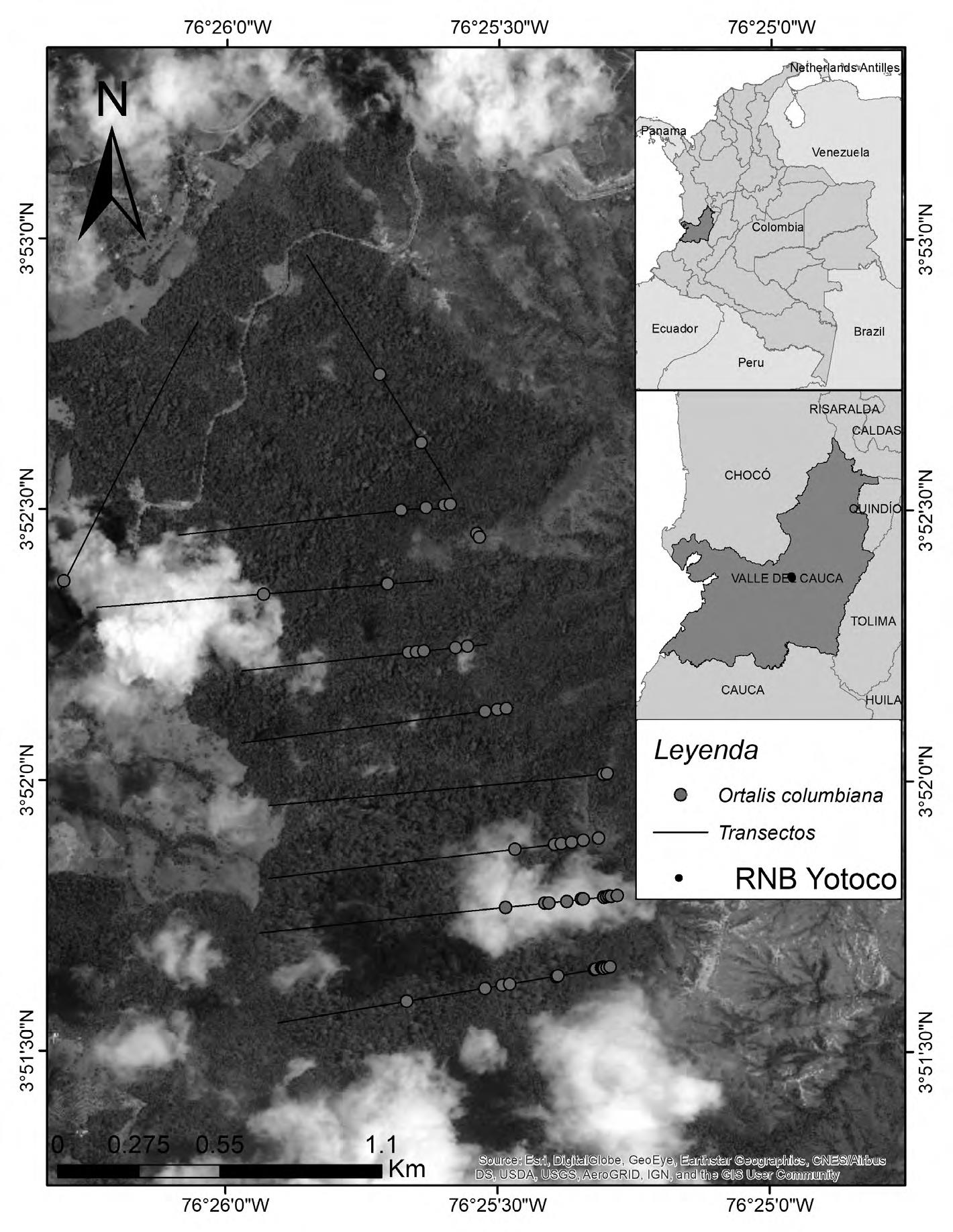Resumen
Las especies endémicas con requerimientos ecológicos muy específicos o bajas densidades poblacionales son prioritarias en términos del diagnóstico de su estado de conservación. Para conocer el de una especie es necesario determinar su abundancia y su tendencia en el marco de programas rigurosos de monitoreo. El territorio del Valle del Cauca ha sido muy intervenido y actualmente solo existen remanentes de bosque, entre ellos, la Reserva Natural Bosque de Yotoco (RNBY), en el municipio de Yotoco. Allí habita Ortalis columbiana, especie endémica de Colombia, cuya densidad no ha sido documentada. En ese contexto, se estimó la densidad poblacional para conocer el estado de conservación de esta especie en la RNBY mediante el método de muestreo por distancia con 32 transectos lineales y más de 200 km de esfuerzo de muestreo. Se encontró una densidad poblacional de 19,2 ind/km2 (IC95%: 9,8-37,6) con un tamaño medio de grupo de 1,56 individuos (IC95%= 1,4-1,8). Este resultado es relativamente mayor que las estimaciones hechas para otras especies de crácidos, únicos referentes de comparación, y sugiere que la población sería de cerca de 100 individuos solo en la Reserva. Este tamaño poblacional podría considerarse bajo para mantener una población viable, no obstante, es importante considerar su presencia y abundancia en los agroecosistemas adyacentes para llegar a conclusiones sobre su viabilidad poblacional.
Referencias
Bayliss, P. & Choquenot, D. (2002). The numerical response: rate of increase and food limitation in herbivores and predators. Philosophical Transactions of the Royal Society of London. Series B: Biological Sciences. 357 (1425): 1233-1248.
Begazo, A. J. & Bodmer, R. E. (1998). Use and conservation of Cracidae (Aves: Galliformes) in the Peruvian Amazon. Oryx. 32 (4): 301-309.
Bennett, A. F. & Saunders, D. A. (2010). Habitat fragmentation and landscape change. Conservation Biology for All. 93: 1544-1550.
Bertsch, C. & Barreto, G. R. (2008). Abundancia y área de acción del paují de copete (Crax daubentoni) en los llanos centrales de Venezuela. Ornitología Neotropical. 19 Supplement): 287-293.
BirdLife International. (2016). Ortalis columbiana. The IUCN Red List of Threatened Species 2016: e.T22728519A94989120. Doi: 10.2305/IUCN.UK.2016-3.RLTS.T22728519A94989120.en
Buckland, S. T., Anderson, D. R., Burnham, K. P., Thomas, L. (2007). Advanced distance sampling: Estimating abundance of biological populations. Oxford, UK: Oxford University Press. p. 416.
Carbone, C. & Gittleman, J.L. (2002). A common rule for the scaling of carnivore density. Science. 295: 2273-2276.
Donegan, T., Salaman, P., Caro, D., McMullan, M. (2010). Revision of the status of bird species occurring in Colombia 2010. Conservación Colombiana. 13: 25-54.
Flather, C.H., Hayward, G.D., Beissinger, S.R., Stephens, P.A. (2011). Minimum viable populations: is there a “magic number” for conservation practitioners? Trends Ecol. Evol. 26: 307-316.
Gaston, K. J. (1994). Rariry. London, UK: Chapman and Hall. p. 224.
Gaston, K. J. & Blackburn, T. M.. (2000). Pattern and process in macroecology. Oxford, UK: Blackwell Science Ltd. p. 392.
Haugaasen, T. & Peres, C. A. (2008). Population abundance and biomass of large-bodied birds in amazonian flooded and unflooded forests. Bird Conservation International. 18 (2): 87-101.
Hijmans, R. J., Cameron, S. E., Parra, J. L., Jones, P. G., Jarvis, A. (2005). Very High Resolution Interpolated Climate Surfaces for Global Land Areas. International Journal of Climatology. 25 (15): 1965-1978.
Holdridge, L. R. (1947). Determination of World Plant Formations From Simple Climatic Data. Science. 105 (2727): 367-68.
Hutchinson, G. E. (1957). Concluding Remarks. Cold Spring Harbor Symposia on Quantitative Biology. 22 (2): 415-427.
Jenkins, D. G., Brescacin, C. R., Duxbury, C. V., Elliott, J. A., Evans, J. A., Grablow, K. R., Hillegass, M., Lyon, B. N., Metzger, G. A., Olandese, M. L., Silvers, G. A., Suresch, H. N., Thompson, T. N., Trexler, C. M., Williams, N. C., Williams, S. E. (2007). Does size matter for dispersal distance?. Global Ecology and Biogeography. 16 (4): 415-425.
Kattan, G. H., Roncancio, N., Banguera, Y., Kessler, M., Londoño, G. A., Marín, O., Munoz, M. C. (2014). Spatial variation in population density of an endemic and endangered bird, the Cauca Guan (Penelope perspicax). Tropical Conservation Science. 7 (1): 161-170
Kattan, G. H., Muñoz, M. C., Kikuchi, D. W. (2016). Population densities of curassows, guans, and chachalacas (Cracidae): Effects of body size, habitat, season, and hunting. The Condor. 118 (1): 24-32.
Lindenmayer, D.B., Likens, G.E. Haywood, A., Miezis. L. (2011). Adaptive monitoring in the real world: proof of concept. Trends in Ecology & Evolution. 26 (12): 641-646.
Mamani, A. M. (2001). Aspectos biológicos y evaluación de la densidad poblacional de la charata Ortalis canicollis en Izozog, Prov. Cordillera del Dpto. Santa Cruz, Bolivia. En D.M. Brooks and F. González-García (Ed.). Cracid ecology and conservation in the new millenium (pp. 87-100). Houston, USA: Miscellaneous Publications of the Houston Museum of Natural Science.
Matthews, J.N.S. (2006). Introduction to Randomized Controlled Clinical Trials. New York, USA: Chapman & Hall. p. 302.
Rabinowitz, D., Cairns, S., Dillon, T. (1986). Seven forms of rarity and their frequency in the flora of the British isles. En M. E. Soulé (Ed.) Conservation biology: the science of scarcity and diversity (pp. 182-204). Sunderland MA, USA: Sinauer Associates.
Salaman, P., Cuadros, T., Jaramillo, J.G., Weber, H. (2001). Lista de chequeo de las aves de Colombia. Medellín, Colombia: Sociedad Antioqueña de Ornitología. p. 112.
Schmitz-O, A. (1999). Vulnerability of Rufous-Vented Chachalacas (Ortalis ruficauda, Cracidae) to man-induced habitat alterations in northern Venezuela. Ornitologia Neotropical. 10: 27-34.
Stephens, P. A., Vieira, M. V., Willis, S. G., & Carbone, C. (2019). The limits to population density in birds and mammals. Ecology letters, 22(4), 654-663.
Thiollay, J. M. (1994). Structure, density and rarity in an Amazonian rainforest bird community. Journal of Tropical Ecology. 10: 449-481.
Thomas, L., Buckland, S. T., Rexstad, E. A., Laake, J. L., Strindberg, S., Hedley, S. L., Bishop, J.R.B. (2009). DISTANCE. St. Andrews, UK: Research Unit for Wildlife Population Assess ment.
Witmer, G. W. (2005). Wildlife population monitoring: some practical considerations. Wildlife Research. 32 (3): 259-263.

Esta obra está bajo una licencia internacional Creative Commons Atribución-NoComercial-SinDerivadas 4.0.
Derechos de autor 2020 Revista de la Academia Colombiana de Ciencias Exactas, Físicas y Naturales

